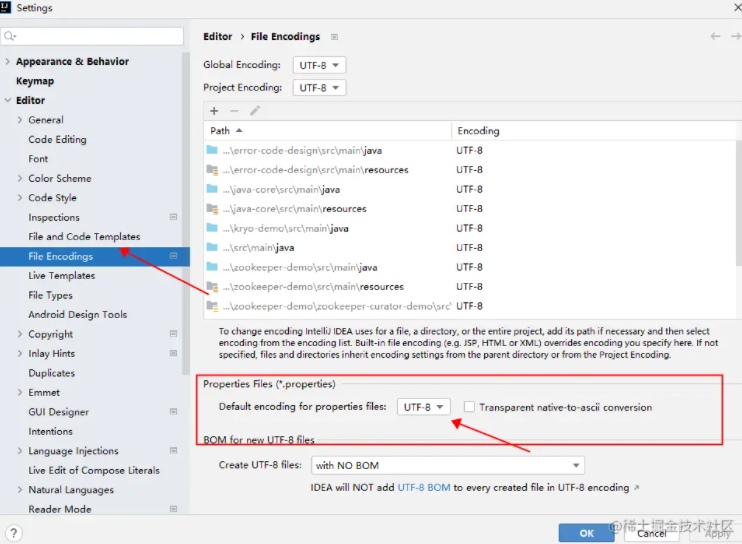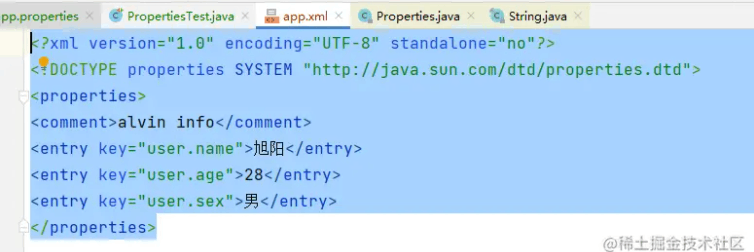Java Properties类
JAVA旭阳 人气:0概述
Properties是JDK1.0中引入的java类,目前也在项目中大量使用,主要用来读取外部的配置,那除了这个,你对它其他的一些api也了解吗? 你了解它是怎么实现的吗? 如果不清楚的话,就通过本篇文章带你一探究竟。
介绍

java.util.Properties继承自java.util.Hashtable,是一个持久化的属性保存对象,可以将属性内容写出到stream中或者从stream中读取属性内容。 它的重要特性如下:
- 在底层的Hashtable中,每一对属性的key和value都是按照string类型来保存的。
- Properties支持文本方式和xml方式的数据存储。在文本方式中,格式为key:value,其中分隔符可以是:冒号(:)、等号(=)、空格。其中空格可以作为key的结束,同时获取的值回将分割符号两端的空格去掉。
- Properties可以将其他的Properties对象作为默认的值。
- Hashtable的所有方法Properties对象均可以访问,但是不建议这么做,因为Hashtable可以存放其他数据类型,这样会导致Properties一些方法调用报错。
- 在properties文件中,可以用井号"#"来作注释。
- 线程安全
- key、value不可以是null
构造方法
Properties()
创建一个无默认值的空属性列表。
Properties(Properties defaults)
创建一个带有指定默认值的空属性列表。
关键方法
getProperty ( String key)
根据指定的key获取对应的属性value值,如果在自身的存储集合中没有找到对应的key,那么就直接到默认的defaults属性指定的Properties中获取属性值。
getProperty(String, String)
当getProperty(String)方法返回值为null的时候,返回给定的默认值,而不是返回null。
load ( InputStream inStream)
从byte stream中加载key/value键值对,要求所有的key/value键值对是按行存储,同时是用ISO-8859-1编译的, 不支持中文。
load(Reader)
从字符流中加载key/value键值对,要求所有的键值对都是按照行来存储的。
loadFromXML(InputStream)
从xml文件中加载property,底层使用XMLUtils.load(Properties,InputStream)方法来加载。
setProperty ( String key, String value)
调用 Hashtable 的方法 put 。他通过调用基类的put方法来设置 键 - 值对。
store ( OutputStream out, String comments)
将所有的property(保存defaults的)都写出到流中,同时如果给定comments的话,那么要加一个注释。
storeToXML(OutputSteam, comment, encoding)
写出到xml文件中。
Set stringPropertyNames()
获取所有Properties中所有的key集合
clear ()
清除所有装载的 键值对。该方法在基类中提供。
使用案例
新建配置文件app.properties
## 用户信息 user.name:旭阳 user.age=28 user.sex 男
通过idea设置它的格式为UTF-8。

验证读取以及中文乱码的问题
@Test
public void test1() throws IOException {
Properties properties = new Properties();
// 使用load inputstream
properties.load(this.getClass().getClassLoader().getResourceAsStream("app.properties"));
// 出现乱码
System.out.println(properties);
// 转码
System.out.println(new String(properties.getProperty("user.name").getBytes(StandardCharsets.ISO_8859_1), StandardCharsets.UTF_8));
Properties properties2 = new Properties();
// 使用load read
BufferedReader bf = new BufferedReader(new InputStreamReader(this.getClass().getClassLoader().getResourceAsStream("app.properties"), "UTF-8"));
properties2.load(bf);
System.out.println(properties2);
}运行结果:

保存为xml格式
@Test
public void test2() throws IOException {
Properties properties2 = new Properties();
// 使用load read
BufferedReader bf = new BufferedReader(new InputStreamReader(this.getClass().getClassLoader().getResourceAsStream("app.properties"), "UTF-8"));
properties2.load(bf);
System.out.println(properties2);
// 保存到xml
FileOutputStream fileOutputStream = new FileOutputStream("app.xml");
properties2.storeToXML(fileOutputStream, "alvin info", "UTF-8");
}
运行结果:

源码解析
源码这部分主要分析下load(Reader)和load(InputStream)这两个最常用的方法,这两个方法是指定从文本文件中加载key/value属性值,底层都是将流封装成为LineReader对象,然后通过load0方法来加载属性键值对的。
public synchronized void load(InputStream inStream) throws IOException {
load0(new LineReader(inStream));
}将inputStream封装程一个LineReader,每次可以读取一行数据。
LineReader源码分析:
class LineReader {
/**
* 根据字节流创建LineReader对象
*
* @param inStream
* 属性键值对对应的字节流对象
*/
public LineReader(InputStream inStream) {
this.inStream = inStream;
inByteBuf = new byte[8192];
}
/**
* 根据字符流创建LineReader对象
*
* @param reader
* 属性键值对对应的字符流对象
*/
public LineReader(Reader reader) {
this.reader = reader;
inCharBuf = new char[8192];
}
// 字节流缓冲区, 大小为8192个字节
byte[] inByteBuf;
// 字符流缓冲区,大小为8192个字符
char[] inCharBuf;
// 当前行信息的缓冲区,大小为1024个字符
char[] lineBuf = new char[1024];
// 读取一行数据时候的实际读取大小
int inLimit = 0;
// 读取的时候指向当前字符位置
int inOff = 0;
// 字节流对象
InputStream inStream;
// 字符流对象
Reader reader;
/**
* 读取一行,将行信息保存到{@link lineBuf}对象中,并返回实际的字符个数
*
* @return 实际读取的字符个数
* @throws IOException
*/
int readLine() throws IOException {
// 总的字符长度
int len = 0;
// 当前字符
char c = 0;
boolean skipWhiteSpace = true;
boolean isCommentLine = false;
boolean isNewLine = true;
boolean appendedLineBegin = false;
boolean precedingBackslash = false;
boolean skipLF = false;
while (true) {
if (inOff >= inLimit) {
// 读取一行数据,并返回这一行的实际读取大小
inLimit = (inStream == null) ? reader.read(inCharBuf) : inStream.read(inByteBuf);
inOff = 0;
// 如果没有读取到数据,那么就直接结束读取操作
if (inLimit <= 0) {
// 如果当前长度为0或者是改行是注释,那么就返回-1。否则返回len的值。
if (len == 0 || isCommentLine) {
return -1;
}
return len;
}
}
// 判断是根据字符流还是字节流读取当前字符
if (inStream != null) {
// The line below is equivalent to calling a ISO8859-1 decoder.
// 字节流是根据ISO8859-1进行编码的,所以在这里进行解码操作。
c = (char) (0xff & inByteBuf[inOff++]);
} else {
c = inCharBuf[inOff++];
}
// 如果前一个字符是换行符号,那么判断当前字符是否也是换行符号
if (skipLF) {
skipLF = false;
if (c == '\n') {
continue;
}
}
// 如果前一个字符是空格,那么判断当前字符是不是空格类字符
if (skipWhiteSpace) {
if (c == ' ' || c == '\t' || c == '\f') {
continue;
}
if (!appendedLineBegin && (c == '\r' || c == '\n')) {
continue;
}
skipWhiteSpace = false;
appendedLineBegin = false;
}
// 如果当前新的一行,那么进入该if判断中
if (isNewLine) {
isNewLine = false;
// 如果当前字符是#或者是!,那么表示该行是一个注释行
if (c == '#' || c == '!') {
isCommentLine = true;
continue;
}
}
// 根据当前字符是不是换行符号进行判断操作
if (c != '\n' && c != '\r') {
// 当前字符不是换行符号
lineBuf[len++] = c;// 将当前字符写入到行信息缓冲区中,并将len自增加1.
// 如果len的长度大于行信息缓冲区的大小,那么对lineBuf进行扩容,扩容大小为原来的两倍,最大为Integer.MAX_VALUE
if (len == lineBuf.length) {
int newLength = lineBuf.length * 2;
if (newLength < 0) {
newLength = Integer.MAX_VALUE;
}
char[] buf = new char[newLength];
System.arraycopy(lineBuf, 0, buf, 0, lineBuf.length);
lineBuf = buf;
}
// 是否是转义字符
// flip the preceding backslash flag
if (c == '\') {
precedingBackslash = !precedingBackslash;
} else {
precedingBackslash = false;
}
} else {
// reached EOL
if (isCommentLine || len == 0) {
// 如果这一行是注释行,或者是当前长度为0,那么进行clean操作。
isCommentLine = false;
isNewLine = true;
skipWhiteSpace = true;
len = 0;
continue;
}
// 如果已经没有数据了,就重新读取
if (inOff >= inLimit) {
inLimit = (inStream == null) ? reader.read(inCharBuf) : inStream.read(inByteBuf);
inOff = 0;
if (inLimit <= 0) {
return len;
}
}
// 查看是否是转义字符
if (precedingBackslash) {
// 如果是,那么表示是另起一行,进行属性的定义,len要自减少1.
len -= 1;
// skip the leading whitespace characters in following line
skipWhiteSpace = true;
appendedLineBegin = true;
precedingBackslash = false;
if (c == '\r') {
skipLF = true;
}
} else {
return len;
}
}
}
}
}readLine这个方法每次读取一行数据;如果我们想在多行写数据,那么可以使用''来进行转义,在该转义符号后面换行,是被允许的。
load0方法源码如下:
private void load0(LineReader lr) throws IOException {
char[] convtBuf = new char[1024];
// 读取的字符总数
int limit;
// 当前key所在位置
int keyLen;
// value的起始位置
int valueStart;
// 当前字符
char c;
//
boolean hasSep;
// 是否是转义字符
boolean precedingBackslash;
while ((limit = lr.readLine()) >= 0) {
c = 0;
// key的长度
keyLen = 0;
// value的起始位置默认为limit
valueStart = limit;
//
hasSep = false;
precedingBackslash = false;
// 如果key的长度小于总的字符长度,那么就进入循环
while (keyLen < limit) {
// 获取当前字符
c = lr.lineBuf[keyLen];
// 如果当前字符是=或者是:,而且前一个字符不是转义字符,那么就表示key的描述已经结束
if ((c == '=' || c == ':') && !precedingBackslash) {
// 指定value的起始位置为当前keyLen的下一个位置
valueStart = keyLen + 1;
// 并且指定,去除空格
hasSep = true;
break;
} else if ((c == ' ' || c == '\t' || c == '\f') && !precedingBackslash) {
// 如果当前字符是空格类字符,而且前一个字符不是转义字符,那么表示key的描述已经结束
// 指定value的起始位置为当前位置的下一个位置
valueStart = keyLen + 1;
break;
}
// 如果当前字符为'',那么跟新是否是转义号。
if (c == '\') {
precedingBackslash = !precedingBackslash;
} else {
precedingBackslash = false;
}
keyLen++;
}
// 如果value的起始位置小于总的字符长度,那么就进入该循环
while (valueStart < limit) {
// 获取当前字符
c = lr.lineBuf[valueStart];
// 判断当前字符是否是空格类字符,达到去空格的效果
if (c != ' ' && c != '\t' && c != '\f') {
// 当前字符不是空格类字符,而且当前字符为=或者是:,并在此之前没有出现过=或者:字符。
// 那么value的起始位置继续往后移动。
if (!hasSep && (c == '=' || c == ':')) {
hasSep = true;
} else {
// 当前字符不是=或者:,或者在此之前出现过=或者:字符。那么结束循环。
break;
}
}
valueStart++;
}
// 读取key
String key = loadConvert(lr.lineBuf, 0, keyLen, convtBuf);
// 读取value
String value = loadConvert(lr.lineBuf, valueStart, limit - valueStart, convtBuf);
// 包括key/value
put(key, value);
}
}会将分割符号两边的空格去掉,并且分割符号可以是=,:,空格等。而且=和:的级别比空格分隔符高,即当这两个都存在的情况下,是按照=/:分割的。可以看到在最后会调用一个loadConvert方法,该方法主要是做key/value的读取,并将十六进制的字符进行转换。
总结
本文阐述了Properties的基本作用以及源码实现,是不是对Properties有了更近一步的认识呢。
加载全部内容